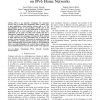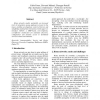130
Voted
CRISIS
2009
14 years 10 months ago
2009
IPv6 is an attractive technology for innovative services such as health care monitoring, alarm systems, peer to peer applications, virtual machine systems and so on. The generaliza...
118
Voted
SOUPS
2010
ACM
15 years 1 months ago
2010
ACM
Home networks are common but notoriously difficult to setup and maintain. The difficulty users experience in setting up and maintaining their home network is problematic because o...
111
Voted
AINA
2006
IEEE
15 years 2 months ago
2006
IEEE
Home networks enable, potentially, an increased level of integration among appliances present in the house, enabling an ubiquitous control of devices and simplifying man/machine i...
102
click to vote
ACMDIS
2008
ACM
15 years 2 months ago
2008
ACM
As computing migrates from the workplace to the home, householders must tackle problems of home network maintenance. Often they lack the technical knowledge or motivation to compl...
117
Voted
APNOMS
2006
Springer
15 years 4 months ago
2006
Springer
In this paper, we propose a new approach to secure and easy-to-use remote access to networked appliances (NAs). Based on the proposed approach, we develop a system in which servers...
107
click to vote
SIGOPSE
2000
ACM
15 years 5 months ago
2000
ACM
As researchers look beyond the PC there is increasing interest in developing and deploying sophisticated home networks. Such networks might allow the seamless integration of infor...
115
Voted
SASN
2003
ACM
15 years 6 months ago
2003
ACM
Until recently, ad hoc networks were mainly used for military and security-sensitive applications. Nowadays, they could also be used in SOHO (Small Office / Home Office) or home n...
102
Voted
HICSS
2003
IEEE
15 years 6 months ago
2003
IEEE
This paper presents au approach to extend OSGi server based home networks with JXTA’s peer-topeer (PZP) technoIogy to a mzdti-server home environment connecting multiple private...
114
Voted
GLOBECOM
2006
IEEE
15 years 6 months ago
2006
IEEE
Abstract— A home network is a residential local area network, in which users are networking their PCs, laptops or wireless multimedia appliances to use a single residential acces...
93
Voted
AINA
2006
IEEE
15 years 7 months ago
2006
IEEE
Abstract— We developed the HAT (Home Appliance Translator) and HAT-Sub to enable conventional appliances without telecommunication capabilities to connect to home networks. The d...


